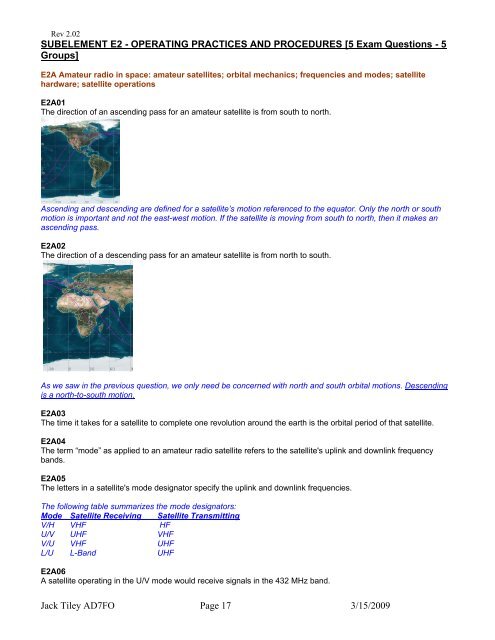You also want an ePaper? Increase the reach of your titles
YUMPU automatically turns print PDFs into web optimized ePapers that Google loves.
Rev 2.02<br />
SUBELEMENT E2 - OPERATING PRACTICES AND PROCEDURES [5 Exam Questions - 5<br />
Groups]<br />
E2A Amateur radio in space: amateur satellites; orbital mechanics; frequencies and modes; satellite<br />
hardware; satellite operations<br />
E2A01<br />
The direction of an ascending pass for an amateur satellite is from south to north.<br />
Ascending and descending are defined for a satellite’s motion referenced to the equator. Only the north or south<br />
motion is important and not the east-west motion. If the satellite is moving from south to north, then it makes an<br />
ascending pass.<br />
E2A02<br />
The direction of a descending pass for an amateur satellite is from north to south.<br />
As we saw in the previous question, we only need be concerned with north and south orbital motions. Descending<br />
is a north-to-south motion.<br />
E2A03<br />
The time it takes for a satellite to complete one revolution around the earth is the orbital period of that satellite.<br />
E2A04<br />
The term “mode” as applied to an amateur radio satellite refers to the satellite's uplink and downlink frequency<br />
bands.<br />
E2A05<br />
The letters in a satellite's mode designator specify the uplink and downlink frequencies.<br />
The following table summarizes the mode designators:<br />
Mode Satellite Receiving Satellite Transmitting<br />
V/H VHF HF<br />
U/V UHF VHF<br />
V/U VHF UHF<br />
L/U L-Band UHF<br />
E2A06<br />
A satellite operating in the U/V mode would receive signals in the 432 MHz band.<br />
Jack Tiley <strong>AD7FO</strong> Page 17 3/15/2009


